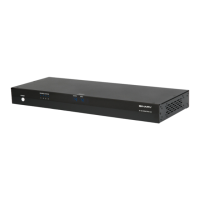11
7.3.1. How to Congure Auto EDID
To set up Auto EDID conguration, rst make sure that all displays are powered on and connected to the matrix
switcher. Then, press the following remote buttons in this order. Be sure to press each button within 10 seconds of
the previous button-press to prevent the command from resetting.
Sets EDID Based on All Connected Displays Display Readout (Example)
1. Press DEFAULT E-
2. Press Number Key 9 AA
3. Press ENTER A0
7.4. Embedded EDID Conguration
In addition to the automatic conguration method, EDIDs in the B-120-HDMATRIX-4x4 can be set to inputs
manually by selecting an EDID from the embedded list (default EDIDs programmed into the matrix switcher).
The matrix switcher contains eight ‘embedded’ EDIDs that may be assigned to inputs. These EDIDs dene groups
of video and audio capabilities that are useful for conguring sources in most systems.
7.4.1. Embedded EDID Chart
Embedded EDID Resolution Color Depth Audio
1 1080p@60Hz 24-Bit 7.1ch
2 (Factory Default) 1080p@60Hz 24-Bit 2ch
3 1080p@60Hz 24-Bit 3D 7.1ch
4 1080p@60Hz 24-Bit 3D 2ch
5 1080i@60Hz 36-Bit 3D 7.1ch
6 1080i@60Hz 36-Bit 3D 2ch
7 1080i@30Hz / 720p@60Hz 24-Bit 7.1ch
8 1080i@30Hz/ 720p@60Hz 24-Bit 2ch
Explanation of Embedded EDIDs
Video Resolution in the Embedded EDIDs is the highest resolution a connected source will output. That is, if the
source is capable of 1080P@60 it will be required by EDIDs 1-6 to provide that resolution. However, if the source
is only capable of 1080i it will output 1080i, etc. It is assumed that any display that can accept the specied video
resolution can also accept all standard video resolutions less than that specied.
Color Depth is the maximum number of bits used to encode color.
3D indicates that the source can output 3D if it is available in the content.
Audio Format indicates the maximum number of audio channels, as well as the audio format that the source is
allowed to output. For an Embedded EDID with 7.1ch Audio Format, the source device will output the highest
audio possible based on the content. For example, if 7.1ch is not available and 5.1ch is available, then the output
will be 5.1ch.The same is true if 2ch stereo is the only audio available from the source. Embedded EDIDs with 2ch
stereo will limit output to that audio format regardless of what is available in the content.
Embedded EDIDs 7 and 8 are provided for legacy displays that can only accept resolutions up to a maximum of
1080i / 720p. The 1080i is listed rst since almost all older HD displays can accept 1080i but not all can accept
720p. For these two Embedded EDIDs, (7&8) the source will output 1080i. Should 1080i not be available, the
source will output 720p.
Note: There is a possibility that 720p may not work for a very small number of older displays that may still be in
use. It will be necessary to use a learned EDID from the display to store in the input EDID of any sources that will
be routed to that display if 720p is not supported. See Section 8.5. EDID Learning on page 18 for directions to set a
learned EDID.
When to Use Embedded EDIDs
• 2-channel audio is required for a particular output.
• Lower video resolution is required for a particular output.

